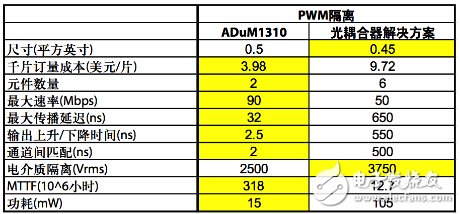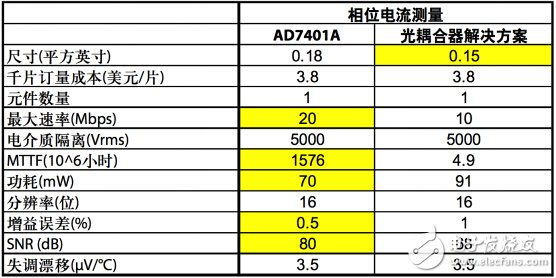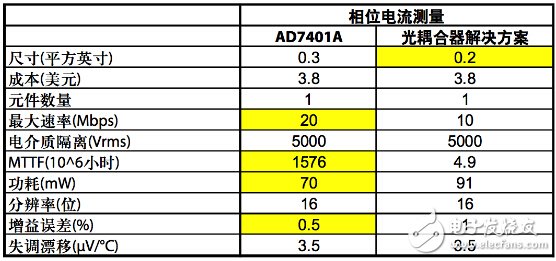Isolation is an integral part of AC voltage motor drive. There are several ways to electrically isolate - mainly optocouplers and digital isolators. Using digital isolators has several advantages over traditional optocouplers—including lower cost, fewer components, and greater reliability. Based on the traditional motor controller design, this paper compares several isolation methods to highlight the advantages of digital isolators.
Background knowledge of optocouplers and digital isolators
The optocoupler uses light from the LED to transmit data through a barrier to a photodiode. When the LED is turned on and off, a logic high and low signal is generated at one end of the electrically isolated photodiode. The speed of the optocoupler is directly related to the rate of the photodiode detector and the time it is charging its diode capacitance. One way to increase speed is to increase the LED current, but at the expense of increased power consumption.
The transformer-based digital isolator magnetically couples data through the isolation barrier via a transformer. The transformer current pulse passes through a coil to form a small local magnetic field that generates an induced current in the other coil. The transmission rate of the transformer is naturally much faster than that of the optocoupler. Moreover, the transformer is a differential architecture with excellent common mode transient immunity. In addition, since digital isolators are based on transformers and optocouplers are based on LEDs, the reliability/MTTF of digital isolators is far superior to optocouplers.
Isolation in motor drive design
Figure 1 shows a block diagram of a high-voltage FlexMC motor control driver developed by Boston Engineering CorporaTIon that interfaces with the ADSP-CM40x mixed-signal control processor. It receives a universal AC input, provides a power factor correction (PFC) front end, drives a permanent magnet synchronous motor (PMSM), and provides the necessary feedback conditioning for a control unit with or without a sensor. The unit operates on ARM. ® CortexTM-M4 mixed-signal control processor ADSP-CM40x and a 16-bit high-precision analog front end. The middle section is an isolation barrier between the high voltage power electronics and the controller. The motor power electronics float with high voltage potential, while the ADSP-CM40x processor is grounded and therefore needs to be isolated. This article will discuss how choosing a digital isolator instead of a photocoupler will improve the design.

Figure 1. Motor control block diagram
In closed-loop motor control design, two key hardware components are pulse width modulation (PWM) controller output and motor phase current feedback. These signals (shown in the block diagram) pass through the isolation barrier. In addition, the use of isolators can benefit several other features, including digital communications and low voltage, low power, and isolated DC-DC conversion.
PWM isolation
Pulse width modulation of the power stage is the core of all motor drives. The switching frequency range is typically 10 kHz – 20 kHz. Precise control of pulse width, dead time, and inter-channel delay is critical when optimizing control performance. When selecting the appropriate isolation device for the PWM control signal, the digital isolator is far superior in performance and cost to the optocoupler option of the same class (see comparison in Table 1).
Table 1. Comparison of PWM Digital Isolators and Optocouplers

For example, the controller will introduce a dead time between the switching signals to prevent any high-side and low-side transistor pairs from conducting simultaneously (ie, through). The dead time is a function of the turn-on and turn-off delay of the power switch and the uncertainty of the delay caused by the isolation circuit. The ADuM1310 digital isolator has an inter-channel matching time of only 2 ns and an optocoupler of up to 500 ns. The use of digital isolators can significantly reduce the dead time and thus the performance of the power inverter. In addition, as shown in the comparison table, in addition to performance, the ADuM1310 is a more integrated solution that reduces component count and bill of materials.
Motor phase current
Most advanced motor drives are based on motor phase current feedback. To provide continuous feedback, the ultra low resistance shunt resistor is connected in series with the motor phase. However, this adds to the complexity of the circuit because of the need to measure millivolt-level signals as well as a hundred-volt common-mode voltage swing with fast dv/dt high-frequency switching. For this design, two AD7401A isolated sigma-delta modulators are used to measure the motor winding current, and the digital bit stream is processed by a digital filtering circuit on the ADSP-CM40x. The ADSP-CM40x's built-in sinc filter allows seamless connection to isolated sigma-delta modulators. The third phase current can be mathematically calculated based on the other two phase currents to reduce power consumption and reduce component cost. The AD7401A integrates a differential sample-and-hold stage, a sigma-delta modulator, and a digital isolation mechanism in a single package. The high voltage side analog signal is converted to a digital serial data stream and then transmitted through the isolation barrier to the low voltage side. The AD7401A also includes a clock input pin that allows simultaneous measurement of each device with a single clock source. As shown in Table 2, there are indeed optocouplers with similar integration and cost in the market; however, digital isolator technology is still more prominent in terms of power consumption, speed and reliability, which is related to the device's infrastructure. Not to mention the excellent modulator performance of the AD7401A.
Table 2. Comparison of phase current digital isolators and optocouplers

Digital communications
I2C is a two-wire, multi-drop communication interface that is typically used to provide digital or analog I/O expansion capabilities to controllers. This method is usually a reserved method for "general management" class functions that are regularly monitored or updated. The FlexMC high-voltage board uses an I2C interface to communicate with the PFC controller while monitoring the bus voltage, bus current, and IGBT temperature with an ADC. In contrast, no optocoupler can provide I2C isolation separately. As a result, as shown in Table 3, the ADuM1250 is an I2C isolation option that is superior to optocouplers in terms of cost, size, component count, and performance. The ADuM1250 allows the ADSP-CM40x controller to monitor all of these functions on the high voltage side through an isolator using only a two-wire peripheral interface.
Table 3. Comparison of I2C Digital Isolators and Optocouplers

Isolated Power
Another advantage that digital isolator technology brings to this design is the ability to generate an ultra-low level isolated power supply. Two ADuM5000 devices are used to generate a 5 V isolated power supply with up to 500 mW of power output capability. These are used to drive the analog end of the sigma-delta converter, which floats with the rapidly changing motor voltage. These isolated power supplies use the same technology as the data isolators, so they all have a built-in transformer with a switching frequency of 180 MHz. This frequency is three orders of magnitude higher than a standard DC-DC converter, allowing for a significant reduction in size. The ADuM5000 device is available in a SOIC-16 package and is a simple solution to provide low power isolation voltage.

About the Author
Gaetano (Guy) Fichera is Director of Electronic Products at Boston Engineering Corpora. Boston Engineering CorporaTIon is an engineering consulting services company that designs and develops next-generation product solutions for commercial and government organizations. We offer an interdisciplinary engineering team that provides guidance to our customers from proof of concept to the entire product lifecycle. With our expertise in robotics to complex electromechanical systems and supply chain development, we are committed to helping our customers solve the challenges they face every day and grow and grow.
Bearing Housing
Shenzhen Joy LED Display Co., Ltd. , https://www.joe-led.com